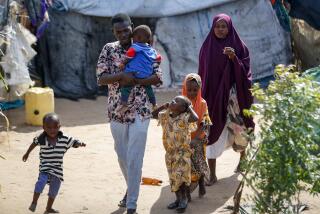Somalians Return to Uncertain Future
BOSSASO, Somalia â No friends or relatives were on hand to greet Natho Aden when she returned to her homeland after nearly 10 years as a refugee in Kenya.
She came back with little to look forward to. But the 30-year-old mother of six, one of 720 Somalis who were voluntarily repatriated by the U.N. High Commissioner for Refugees, said uncertainty at home was better than insecurity in a grim refugee camp in northern Kenya.
Before leaving the Dadaab camp a day earlier, Aden said she knew there was no central government in Somalia, but she also said bandits had attacked the Kenyan camp three times last year.
The spillover into Kenya of the 9-year-long civil conflict in neighboring Somalia has furnished roving gangs with numerous weapons, and attacks on the refugee camps are increasing.
âI came with nothing, and now I am going back with a sick child after 10 years,â Aden said as she packed up her meager belongings. âIt is like my life had stopped for the 10 years I have been here as a refugee.â
Originally from Bossaso, a port on the Gulf of Aden in northeastern Somalia, Aden had moved to the southern Juba region, where she was a peasant farmer growing corn and sunflowers.
âLife was good in my country before the war broke out,â she said.
When Somaliaâs national government collapsed during a civil war in 1991, clan-based fighting engulfed the country. Aden fled to Kenya.
âOne day, people with guns came. They started shooting at us. Those who died were dead. Those who were alive--we fled,â she said, explaining that she walked 125 miles to get to Kenya.
Kenya currently is host to 200,000 refugees--down from more than 500,000 five years ago. There are 140,000 Somalis. The remainder have fled conflicts in Sudan, Ethiopia, Rwanda, Burundi and Congo.
For the 720 Somalis who agreed to be flown home, the U.N. refugee agency provided each family with $170, food rations for nine months, one navy blue tent and blankets. The plane flights and aid cost $800,000, said Colins Asare, director of the Dadaab camp.
Kenyan authorities fingerprinted the departing refugees and issued I.D. cards to those who remained. Some of the refugees turned violent during the process, stoning officials and burning two huts.
To the outsider, there is no apparent difference between Somalis from Somalia and ethnic Somalis who have lived in Kenya for generations. But some refugees have been accused of returning to Somalia to get the U.N. grant, then coming back for another round as refugees.
âThere is nothing unusual about this. The revalidation exercise is to identify genuine refugees,â said George Orago, the Dadaab district officer for the Kenyan government.
When the planes touched down at Bossaso airport, members of a womenâs welfare association sang âSodo walo, sodo waloâ--welcome in Somali--and officials from the new statelet of Puntland in northeastern Somalia were on hand to receive the refugees.
Boarding a truck, Abbas Maalim, a 25-year-old returning refugee, said it was good to be home. Then he added: âBut I donât know where Iâm going to restart my life.â
*
On the Net:
U.N. Somalia page: https://www.unhcr.ch/world/afri/somalia.htm
U.N. Kenya page: https://www.unhcr.ch/world/afri/kenya.htm
More to Read
Sign up for Essential California
The most important California stories and recommendations in your inbox every morning.
You may occasionally receive promotional content from the Los Angeles Times.










